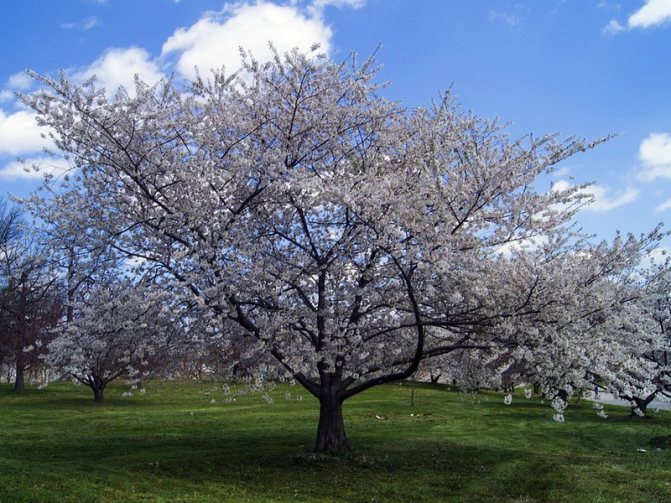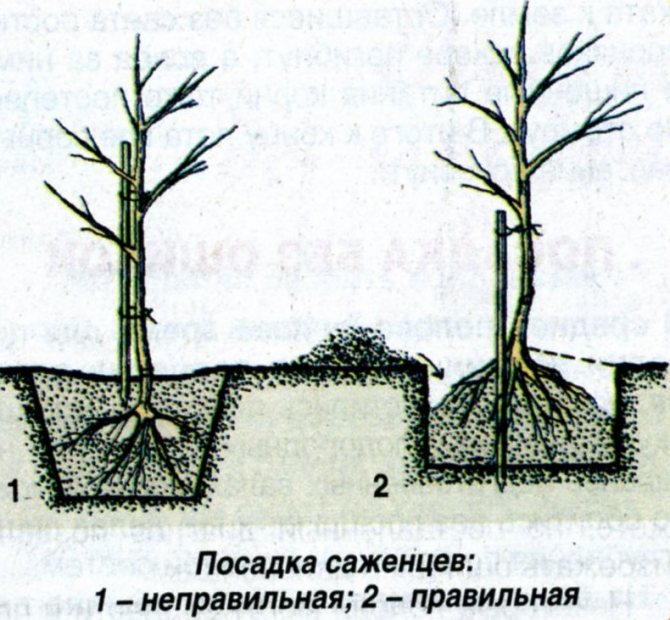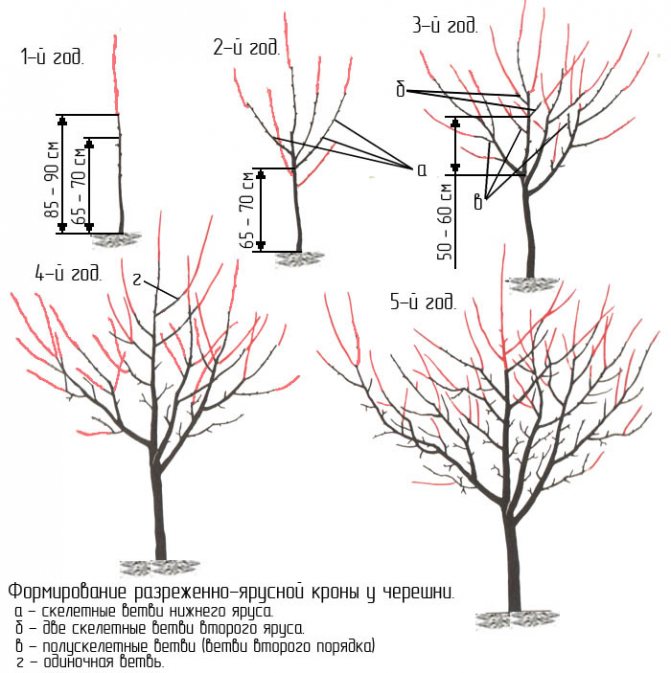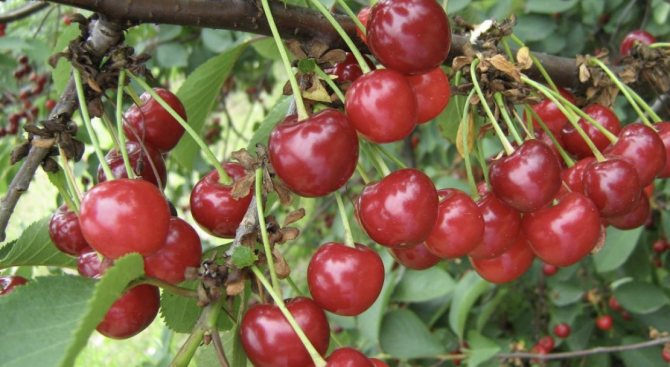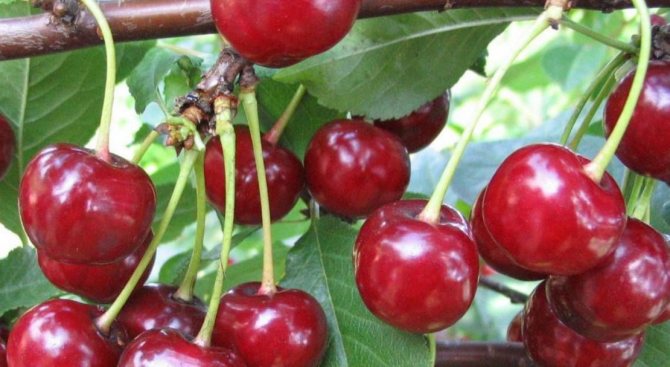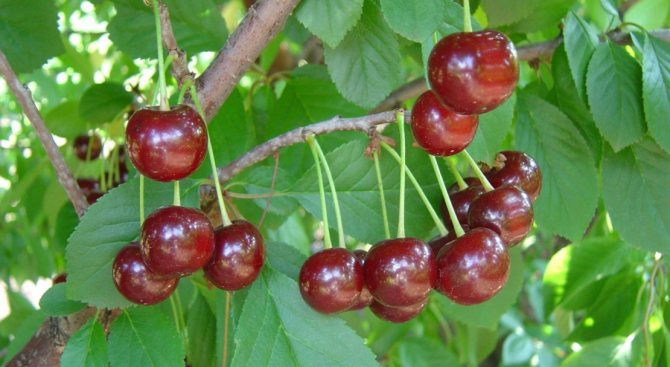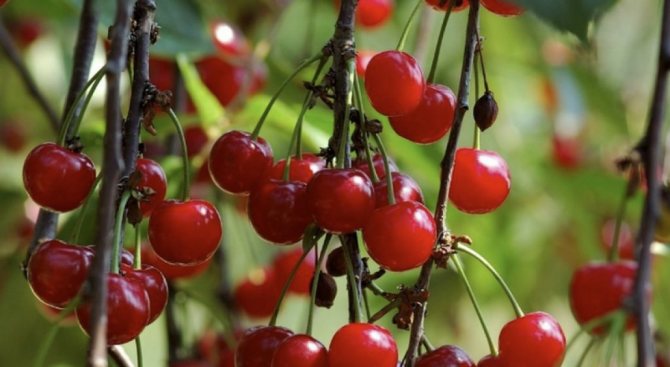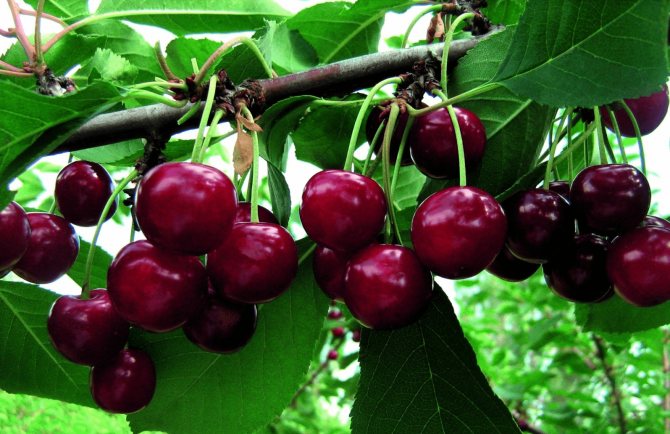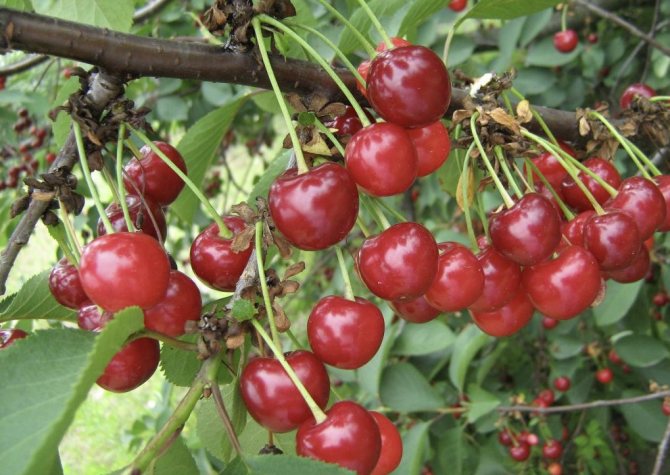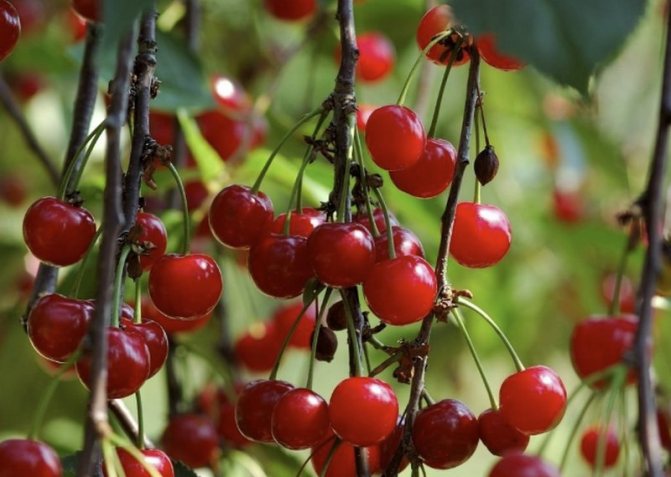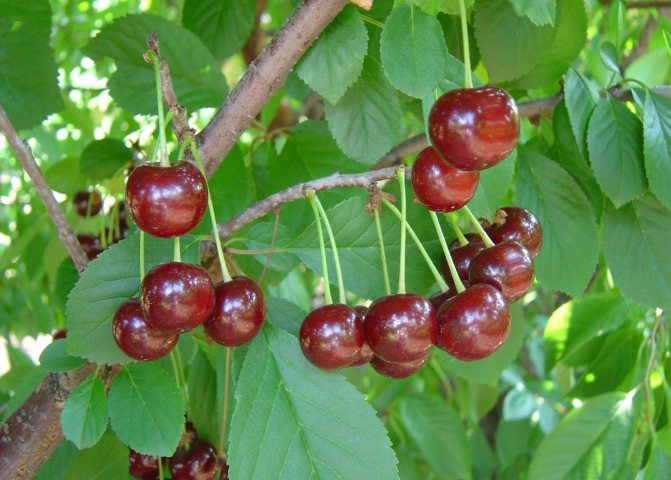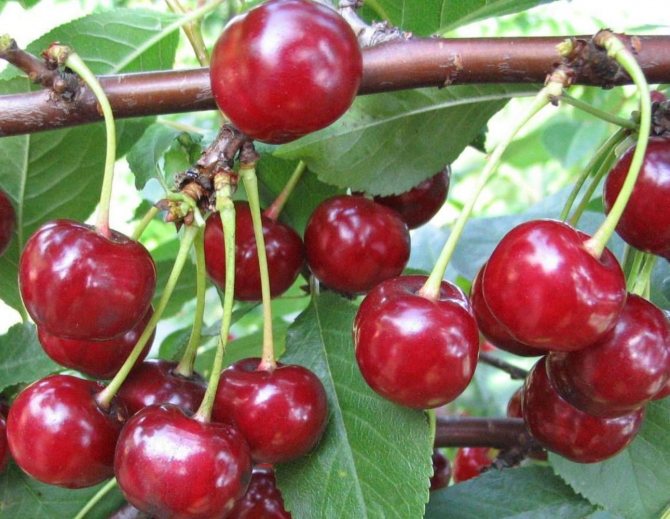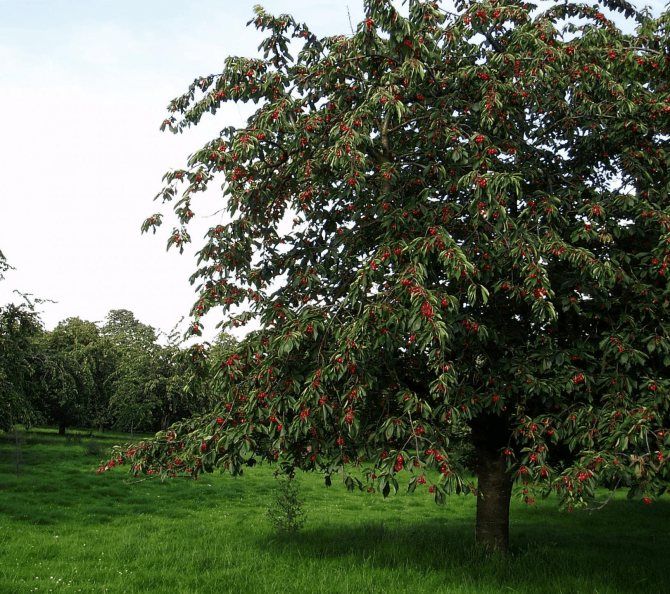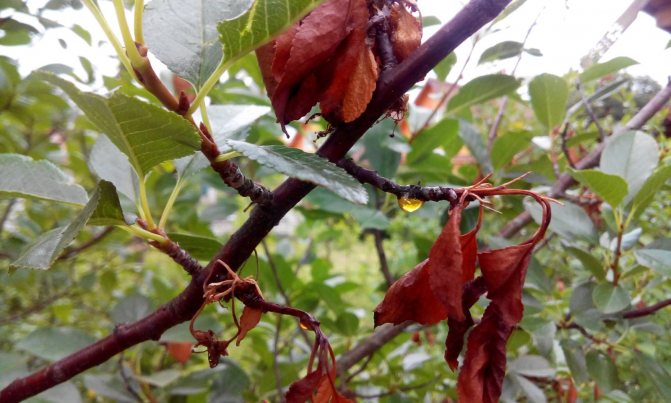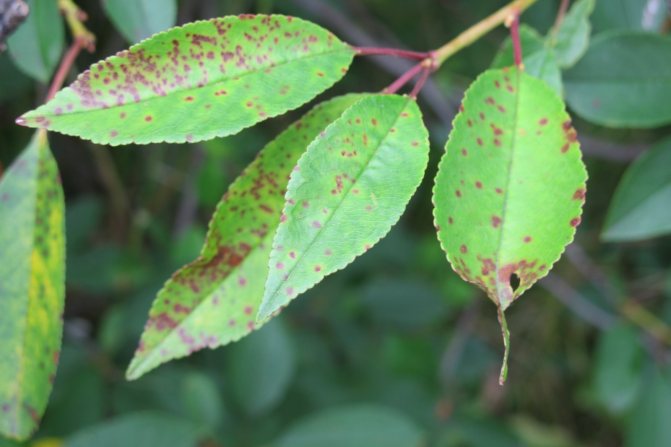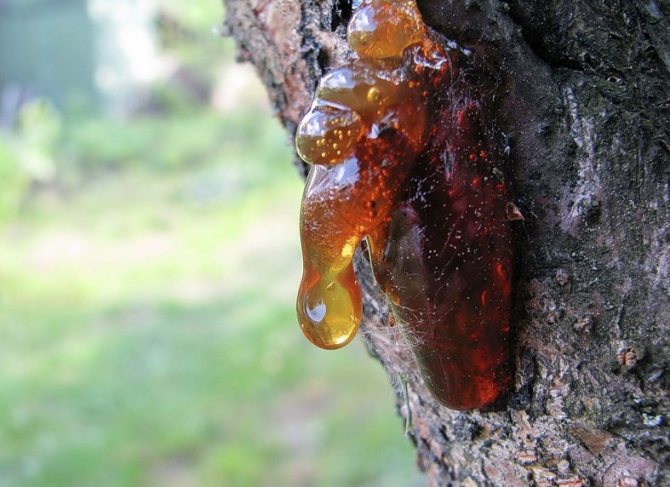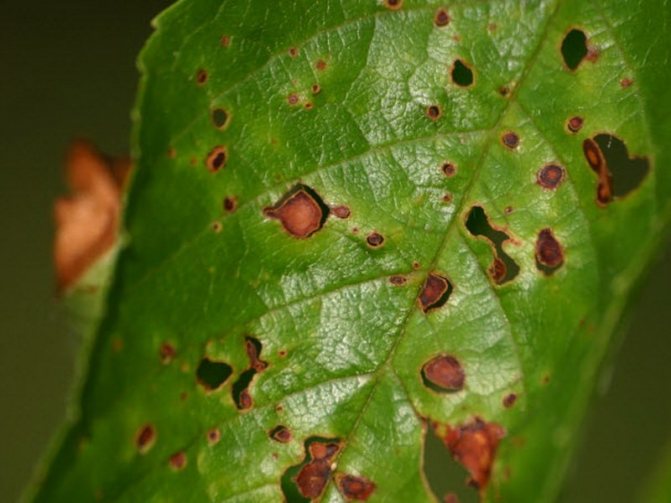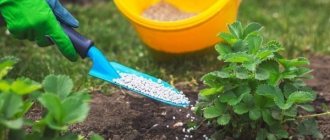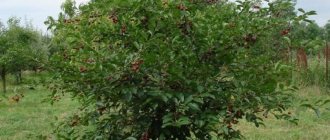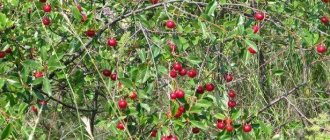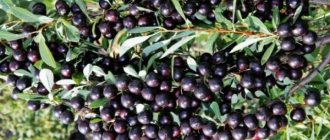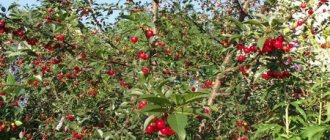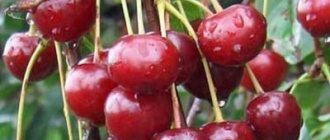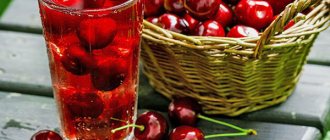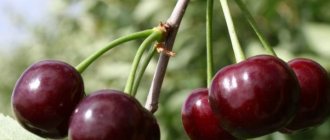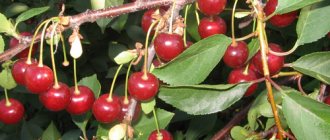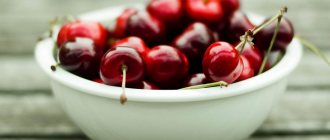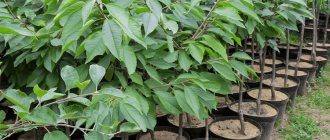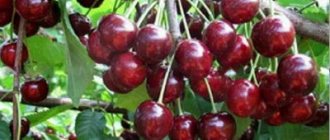02/03/2017 Cherry "Toy" is not quite a cherry. It is a hybrid of cherry and sweet cherry; such hybrids are called ducs. The variety was bred at the Institute of Irrigated Horticulture. MF Sidorenko UAAN as a result of crossing of “Lyubitelskaya” cherry and “Solnechny ball” cherry. The authors of the variety are Valentina Alekssevna and Nikolai Ivanovich Turovtsevs. By the way, Nikolai Ivanovich has several dozen varieties of cherries and cherries.
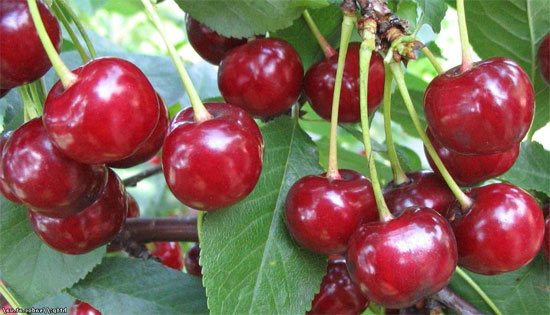
According to VNIISPK, in the State Register "Toy" was registered in 1996 and zoned for the North Caucasian region, but now it is not in the register itself.
Cherry variety compatibility
For a good yield of cherries, it is necessary to select varieties with high compatibility for pollination, since a combination of incompatible varieties can only result in a bad harvest. Experts advise to select and plant several varieties nearby with similar flowering, fruiting and ripening dates. Alternatively, good compatibility can be advised to plant a variety of cherries Chernokorka with pollinators: Lyubskaya, sweet cherries Yaroslavna, Donchanka, Aelita;
- grade Alpha with Vladimirsky, Griot, Shubina;
- grade Ashinsky with Rubinov, Nochka, Altai swallow;
- grade Zhukovsky with Lyubsky, Vladimirsky;
- grade Kanzan with Turgenevka, Molodezhny, Podbelsky.
Cherry variety "Miracle cherry"
Among the fairly new favorite varieties of cherries, the large-fruited "Miracle Cherry" is especially favored by amateur gardeners. "Miracle - cherry" was obtained by crossing two of the most delicious fruit - cherries and cherries and is famous for its tasty large fruits, each of which, when fully ripe by the end of June, can gain weight up to 7-8 grams. Pretty sweet, dark-colored cherries with a shiny skin, conveniently located on a medium-sized tree under the same medium-dense crown. The seedlings of this plant are quite strong in appearance and differ little from the cherry seedlings. The fruiting period begins already in the fifth year after planting and on average the yield obtained can range from 10 to 20 kilograms of cherries from one tree. "Miracle - cherry" tolerates frost and drought equally well, and also has good immunity to diseases such as coccomycosis and moniliosis. Like the vast majority of new cherry varieties, this species is self-fertile, so to get tasty large berries, it is advisable to plant varieties nearby for pollination. The best "Miracle - Cherry" is pollinated with cherries, and Donchanka, Annushka, Priusadebnaya are considered to be high-quality pollinators. From cherries, pollinators can be - Minx, Melitopol joy or Favorite.
Besides, "Miracle - cherries" large-fruited varieties include "Toy", "Minx", "Malyshka", "Malinovka" and others. However, often planting these large-fruited species, amateur gardeners were disappointed when they received the result in the form of large, but few fruits. While observing the trees in full bloom, a good harvest would be expected. Experts explain this by the fact that for abundant fruiting, an ovary is needed for at least 20 - 40 percent of cherries, and as an option to improve the situation, they suggest planting self-fertile varieties nearby that do not need outside help.
Cherry variety "Toy"
Also among the large-fruited beautiful representatives of cherries, which are popular among amateur gardeners, is the Toy variety, which ripens at the end of June. Trees of this variety belong to the category of vigorous ones with a round, dense crown. Cherries "Toys" are dark cherry in color, have a sweet taste with a slight sourness, are large enough, when ripe they reach about 7-8 grams in weight each. Cherries are equally good for consumption, both fresh and for processing for delicious juices or wine. Presumably, this species owes its name to beautiful, large, toy-like fruits. Although the variety is self-fertile, it is quite fruitful. Begins to bear fruit already in the third year after planting and continues to give a good harvest for 20 - 25 years. When planting seedlings of this variety, you should take care of placing nearby pollinators from representatives of sweet cherry: Large-fruited or Valery Chkalov and cherry varieties: Minx or Samsonovka. "Toy" tolerates winter frosts and droughts well, and also has the lowest incidence of coccomycosis and moniliosis.
Cherry variety "Minx"
Another well-known among cherry representatives in Ukraine is the variety "Shalunya", which was bred by crossing the species "Samsonovka" and "Kievskaya - 19" back in 1966 and since then has been confidently leading among favorites. "Minx" refers to vigorous trees with a fairly wide round crown with large maroon berries - about 6 grams each, with juicy pulp and sweet - sour taste. Ripening of tasty fruits begins in the second decade of June, approximately 4-5 years after planting. The variety belongs to the types of average yield and upon reaching the age of 10, up to 30 - 40 kg of cherries can be harvested from one tree. Like most representatives of large elite varieties, "Minx" is self-fertile and needs cherries planted nearby: "Chernokorka", "Samsonovka", cherries - "Vinka". The variety is valuable not only for its delicious berries, but also for its good immunity to diseases, resistance to frost and drought.
Description
The tree is powerful, tall, up to 7 meters high, which greatly complicates maintenance and harvesting. The crown is spherical, well leafy. Cherry shoots are erect, thick, covered with smooth brown-brown bark with numerous large gray lenticels. On the trunk and branches, the bark is gray, flaky. The leaves of this variety are similar to cherry, large and wide, ovoid, with a pointed top and rounded base, dark green in color. The serrated-toothed edges of the plate are slightly raised upward, giving the leaf the shape of a boat, but at the same time the apex is bent downward. Stipules are short, strongly dissected, and fall early. The petiole is anthocyanin-colored, short and thick. The glands are arranged in 2 - 3, they are rather large, rounded, colored. Duke inflorescence consists of 2 - 3 large white flowers, on average, there are 284 buds for every hundred fruit buds. The Toy's crop is formed on annual growth and bouquet branches.
Drupes are one-dimensional, rather large, weighing 7.0 - 9.0 grams, round-heart-shaped. The apex is rounded, there is a depression at the base, the fossa is shallow and narrow, the abdominal suture is small, inconspicuous. A thick, medium-long stalk can be easily separated from the branch; it is not firmly attached to the stone. The skin is thin, shiny, easily separates from the pulp. During ripeness, cherry fruits turn dark red. The pulp is dark-colored, tender and juicy. The taste is good, dessert, sweet and sour, rated by tasters at 4.5 points. The juice is colored red. The stone is round, small, easily removed. 100 grams of pulp contains: solids 17.4%, sugars 10.9%, acids 1.51%.
Cherry variety "Griot Podbelsky"
Winter-hardy cherry variety "Griot Podbelskogo" refers to a medium-sized species with a round crown with large green leaves. 3-4 years after planting, from mid-June, the berries begin to ripen gradually and continue until mid-July with large 4 -5 gram fruits. Cherries are sweet and sour, quite aromatic and have a shiny, dark-burgundy skin. Seven-year-old cherry gives up to 12 kg of excellent fruits from one tree and has good prerequisites for increasing yields. A caring attitude to the plant can increase fruiting up to 40 kg. The disadvantages of this species include weak endurance not only in winter frosts, but also in spring frosts. Therefore, this variety is most suitable for areas with little frost.
Berries "Griot Podbelskiy" are highly valued for their excellent taste, they are used fresh and processed into different delicacies (preserves, compotes, jams) for the winter. Unfortunately, cherries do not tolerate transportation very well.
Care
Cherry Toy does not require special care from the gardener. However, adherence to certain approaches will ensure the favorable development and fruiting of cherries.
It is not worth watering the Toy tree abundantly. In the main stages of development: flowering, ovary, ripening of berries, completion of fruiting, pre-winter period - under each trunk, into a ring groove, a total of about 9 buckets of water are poured.
The plant responds favorably to loosening the trunk circle. In order not to damage the roots of the tree, it is recommended to combine loosening with piercing the soil with a pitchfork.
A necessary process for the formation of a plant is crown pruning. For the successful development of annual shoots that bear fruit, the crown is thinned out, removing damaged shoots.
The tree should be protected from burns by the bright rays of the sun in early spring. To do this, the barrel can be whitened or a protective layer can be created using white paper. A double wrap in white sheets is enough to prevent the sun from harming the cherries.
Cherry Toy is not susceptible to diseases and pests if prevented. To do this, after the beginning of flowering, trees are treated with suitable insecticides (for example, Inta-vir, Mustang, etc.) in accordance with the instructions. If signs of fungal diseases are detected (dark spots, drying out of leaves), a solution of ferrous sulfate (5-7%) is used. It will help not only to cope with fungal diseases, but also promotes the growth of new branches, the appearance of fruit buds.
Preparing the tree for the winter period, it is fertilized with compost. A layer of compost (10 cm) is added under the root, which is then mulched, covered with crushed peat.
Cherry variety "Melitopol dessert"
Also, it feels great almost throughout the entire territory of Ukraine, a rather promising fruitful variety, obtained as a result of crossing cherries with cherries - "Melitopolskaya Dessertnaya". A vigorous tree with a rounded crown begins bearing fruit in mid-June as early as the fifth year after planting. The first harvests of large 6-8 gram fruits are rather modest and only by the age of 12 years, the maximum harvest is possible. The aromatic dark cherry berries are sweet and good, both fresh and in a variety of canned delicacies. The variety is not particularly picky about living conditions, has good immunity to diseases of fruit and harmful insects, as well as good winter and drought resistance. The species is partially self-fertile, the best pollinators for it are cherries: Zhukovskaya, Lyubovskaya or cherries: Chernyavka, Bigarro Oratovsky.
Having familiarized yourself with promising cherry representatives, you will have to make your choice in favor of one or another variety.And if, your preference is given to large-fruited types of cherries for the excellent taste of large fragrant berries, as an option, you can try to increase their yield by grafting cuttings from different varieties - pollinators. If it is quite difficult to determine the pollinator variety, then using from 4 to 8 different species for grafting, there is an almost 100 percent probability that the desired variety will be among them. Also, seedlings grown on the territory of your region bear fruit well, and having made such a choice, you can support your domestic producer.
We can only wish you a decent harvest in the difficult, but such a pleasant career of an amateur gardener !!!
Helpful article?
Features of planting a tree
To grow a strong tree that will delight with the harvest every year, you need to responsibly approach its planting.
Choosing a suitable site and planting material
With a lack of sun, the berries of this stone fruit culture will be too sour and will deteriorate, therefore the site must be well lit and protected from the winds. Better if it is a place on a dais. The soil must be drained, without stagnant water. The best option is sandy or loamy soil. The distance to the nearest tree should be about 3 meters.
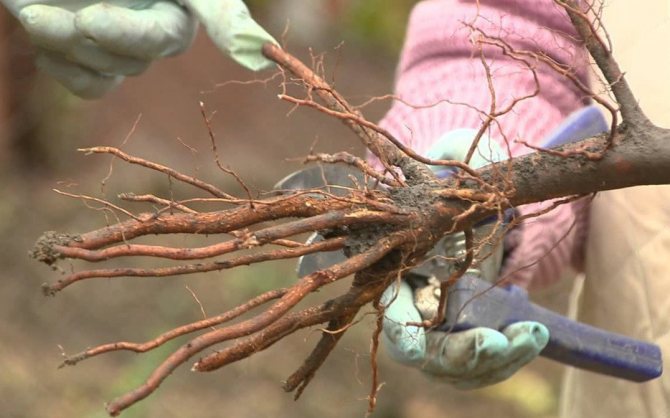

Plant cherry seedlings immediately in a permanent place, since she does not like transplants, especially at 3-4 years of age. When choosing a seedling, you need to pay attention to the condition of the roots. They should have many branches, with no signs of damage or blackness. The tree itself should be even, with a stem about 60 cm high and skeletal branches of the same length. On the bark, cuts, peeling it from the trunk, traces of damage by rodents are not permissible.
Important! After planting, it is necessary to prune the branches 1/3 of the length to create a balance between the roots and the aerial part.
Direct landing technology
It is better to start planting work in the spring, as soon as the ground warms up. Better to be in time before the kidneys swell. The step-by-step process looks like this:
- First, at the chosen place, they dig up the earth on the bayonet of a shovel and mix it with organic fertilizers. They are brought in at the rate of 15 kg per 1 m². If the soil is acidic, then it is slaked with lime at the rate of 0.4 kg per 1 m².
- If the seedling was dug up a few days ago or even in the fall, then the roots are cut to living tissue and dipped in water for a couple of hours.
- If the hole has not been prepared since the fall, then it's time to dig it. Its depth is usually about 60 cm, and its diameter is about 80 cm. The lower, infertile soil layer is thrown away, and compost or part of the fertile layer with organic matter is introduced in its place. Phosphorus-potassium fertilizers are also added - 200 g and 60 g, respectively.
- The root collar should not go deep, so the planting is carried out on an earthen roller, which is formed in the center. A strong wooden stake is also stuck into it, to which the seedling will be attached.
- A cherry is placed on the roller, straightening the roots. Around the soil is evenly covered and tamped.
- Then pour two buckets of water in a circle and mulch the surface.

